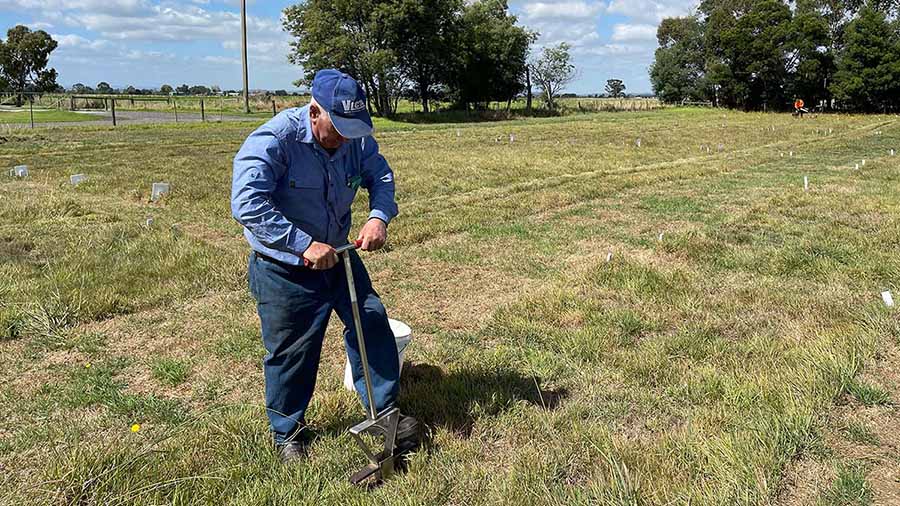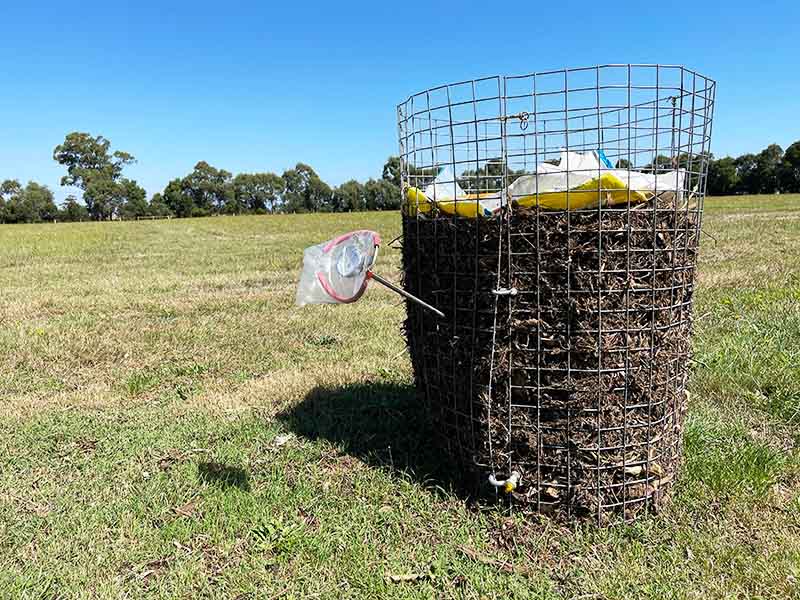There are a number of features that can be observed in a piece of land that can suggest that soil microbiology is not functioning as it should. If there is a dominance of weedy species, bare patches, poor water utilization, erosion and slow recovery after a pasture is grazed, it may be due to an imbalance or even the non-existence of a functioning soil food web. With Dr Cole's help, we've identified a four-step plan to restore the soil food web on a property and reduce or eliminate synthetic chemical use.
How to restore the soil food web?
Step 1: Identify a baseline
The first step in restoring a balanced soil food web is identifying which microorganisms are present and which are missing, or developing a 'baseline' as Dr Cole calls it. This can give a good picture of the condition of the soil and a solid starting point for improving it. 'A doctor doesn't prescribe medicine without first identifying what the patient is suffering from; it's the same for soils,' Dr Cole says. 'You can't effectively treat a problem without first knowing what that problem is.'

Soil samples can be sent to a number of independent laboratories around the country where they'll be analysed and a plan for reintroducing the missing microbes can be established. As well as looking at what microbes are present or missing, soil scientists will also look at the texture of the soil. A crumbly dry soil with little structure might suggest an absence of organic biomass such as deep healthy roots and fungi. These sorts of soils will lack water-holding capacity and therefore have poor drought resilience. On the other hand, soil that is soggy and smelly is anaerobic, meaning that there is a drainage problem and soil could have an excess of pathogens.
Soil scientists will require additional information on the property the sample originated from, including location, climate and produce type, in order to make recommendations on how to restore the soil to optimal health. At an independent pathology lab like Agpath, a complete test of the structural, biological and chemical makeup of a soil sample will cost around $500.
Step 2: Grow and support beneficial microorganisms
When a baseline is identified with the help of a soil pathologist, the journey towards balancing the soil food web can begin. One of the best ways to start supporting and encouraging a diversity of microbiology in soils is by creating bio-complete amendments on-farm. Dr Cole highlights the availability of resources on and within easy reach of most farms. 'You've got to change your mindset from seeing something as waste to seeing it as a resource,' Dr Cole says. Waste organic matter will break down regardless, and through the art of composting, farmers can work with the decay process to grow soil microbes, improve their soil health and see productivity gains. Windrow composting is a composting method that is well-suited for large-scale operations.

An effective composting system requires the correct ratio of carbon (fungal food) to nitrogen (bacterial food). A good ratio of carbon to nitrogen in compost is around 30-1 or 30 parts carbon for each part nitrogen by weight. Mouldy or broken-down hay bales can be used as a good base of carbon in compost windrows. Other carbon-rich materials that are great for composting include dry leaves, wood chips, sawdust, mixed paper, cardboard and bark. For the nitrogen component, manure, vegetable scraps, coffee grounds and green grass clippings are effective options. Dr Cole highlights that these things are often readily available on or close to most farms and should be utilised rather than wasted to close the loop of soil nutrition.
Compost can even be customised for different production types. For example, a fungal-dominated compost will be more effective for perennial pastures, orchards and vineyards, whereas a bacterial-dominated compost will yield better results for an annual horticultural or cropping enterprise. You can feed your compost a predominance of fungal food (higher carbon) for a perennial situation, or a more even fungal-to-bacterial ratio for annuals.
For large-scale operations, making enough compost to cover the entirety of a property can be unrealistic. However, a small amount of compost can go a long way when it is used to create a liquid biological input or compost tea. Compost teas are efficient for application over larger areas and can be just as beneficial for boosting soil microbiology when applied correctly.
As well as implementing an effective composting system, there are many things farmers can do to support their soil food web further. For example, rock dust is an inexpensive resource that can be sourced from quarries. The elements locked up in the rock dust act as a slow-release fertiliser. When the plants and soil biology need the minerals, the microbes will mine them, but until then they won't leach or go to waste. Spraying diluted milk whey offers many benefits for soil microbial communities and can reduce the occurrence of plant pathogens.
Finally, one of the applications that Dr Cole uses regularly on her own property is a mix of simple molasses to feed soil bacteria, and fish or kelp hydrolysate which is made up of organic matter and filled with microbes and minerals. This mix is applied to pastures after grazing to give the soil a boost or, as Dr Cole describes it, an 'ice cream' after working hard to support the stock.
Step 3: Ongoing management practices
As well as applications of compost and other resources that support soil microbes, management practices are critical to the healthy functioning of the soil food web.
No matter what is being produced, Dr Cole stresses the importance of her concept '100% cover, 100% of the time'. Keeping the soil blanketed with cover crops, green manures, annuals or mulches provides a range of benefits. It protects the soil from erosion, preventing valuable organic matter and nutrients from being lost to water and wind. Keeping the ground covered with vegetation provides food and habitat for soil organisms, allowing nutrient cycling to continue. Ground cover also reduces the evaporation of moisture from the soil and allows for better water infiltration. Finally, cover regulates the soil temperature, keeping it cool in summer and warm in winter, which means soil microbes thrive year round.
Grazing
In a grazing situation, implementing rest is very important when trying to rebuild or support the soil microbiome. 'You want to graze as though you have a migratory herd,' Dr Cole says. 'Or, in other words, implement a rotational grazing system.'
Dr Cole recommends moving the herd on when about 50% of the green material is left. That way the pasture will have enough material remaining for efficient photosynthesis which means plants can quickly release root exudates which stimulate the soil microbes. Through nutrient cycling, the microbes then provide nutrients back to the plant for far more rapid pasture regeneration.
Another way of supporting and restoring a functioning soil food web in pastures is by encouraging biodiversity as much as possible. Incorporating multispecies forage crops offers a host of benefits to the soil. A mix of plants will offer diverse root systems which can help soil structure and drought and erosion resilience. Diverse root systems also create a diversity of root exudates which attract a wide variety of soil microorganisms. Multispecies forage crops also allow for better stock health, as animals will self-select based on nutritional and medicinal requirements when they have the opportunity.
Cropping
For cropping operations, one of the conventional practices that can cause the most damage to the soil food web is ploughing or burning off the stubble after harvest. Dr Cole recommends planting into the stubble to maintain soil structure and root biomass from the last season. This practice minimises the disturbance of the structural 'homes' of the microbes, as well as maintaining plenty of organic matter as a food source for microbial life. As microbes feed on this organic matter, they provide nutrients to the new crop in a closed-loop cycle of fertility.
Pasture cropping is also a fantastic way of keeping the soil covered while encouraging microbial life between broadacre cropping seasons. Pasture cropping involves sowing annual crops into perennial (often native) pasture species. The pasture is then grazed, slashed or crimped before the annual crop is planted into a bed of rich organic matter. This organic matter acts as a mulch to protect the soil and keep it moist, which stimulates soil organisms, as well as becoming a food source for microbes as it breaks down.
Orchard/vineyard
For growers, ground cover is of utmost importance. Dr Cole recommends multispecies cover crops between production rows. Having a diversity of cover crop species introduces biodiversity both in the soil and above the ground. Flowing varieties that encourage beneficial insect populations will also help with pollination and pest control.
Another great way to boost the soil's microbiome is by aerating it. Aeration will create an aerobic environment, helping soil bacteria and fungi thrive, as well as improving water-holding capacity.
Step 4: Monitor for improvements
After implementing a biologically complete amendment program and management practices to help build and support the soil food web, observation and monitoring for results are important steps.
One of the easiest ways to monitor the progress of building up your soil food web is by regularly testing the sugar levels in your forage plants or crops. Seeing a steady rise in the sugar levels of your plants means that the soil nutrient cycling is improving and plant nutritional value is increasing. This will mean better feed efficiency and animal health for grazing operations and higher yields and better pest and disease resistance for cropping operations.
A Brix Refractometer is a simple and inexpensive piece of equipment that farmers can use to test sugar levels in whatever they are growing. The tool is usually under $100 and measures the level of sucrose within a sample through refraction. It's best to test using a Brix Refractometer in the mid-afternoon, once every one to two weeks, to start monitoring the changes in forage plants or crop sugar levels.
Farmers implementing these changes will also notice significant improvements in the cost of production, productivity and profitability. 'But more than that,' says Dr Cole, 'you will feel this indescribable sense of peace because you are working with the land instead of against it.
'If you bring your whole enterprise as close as possible to what nature would do without humankind's interference, then you are maximising the energy that's in the planet.'


